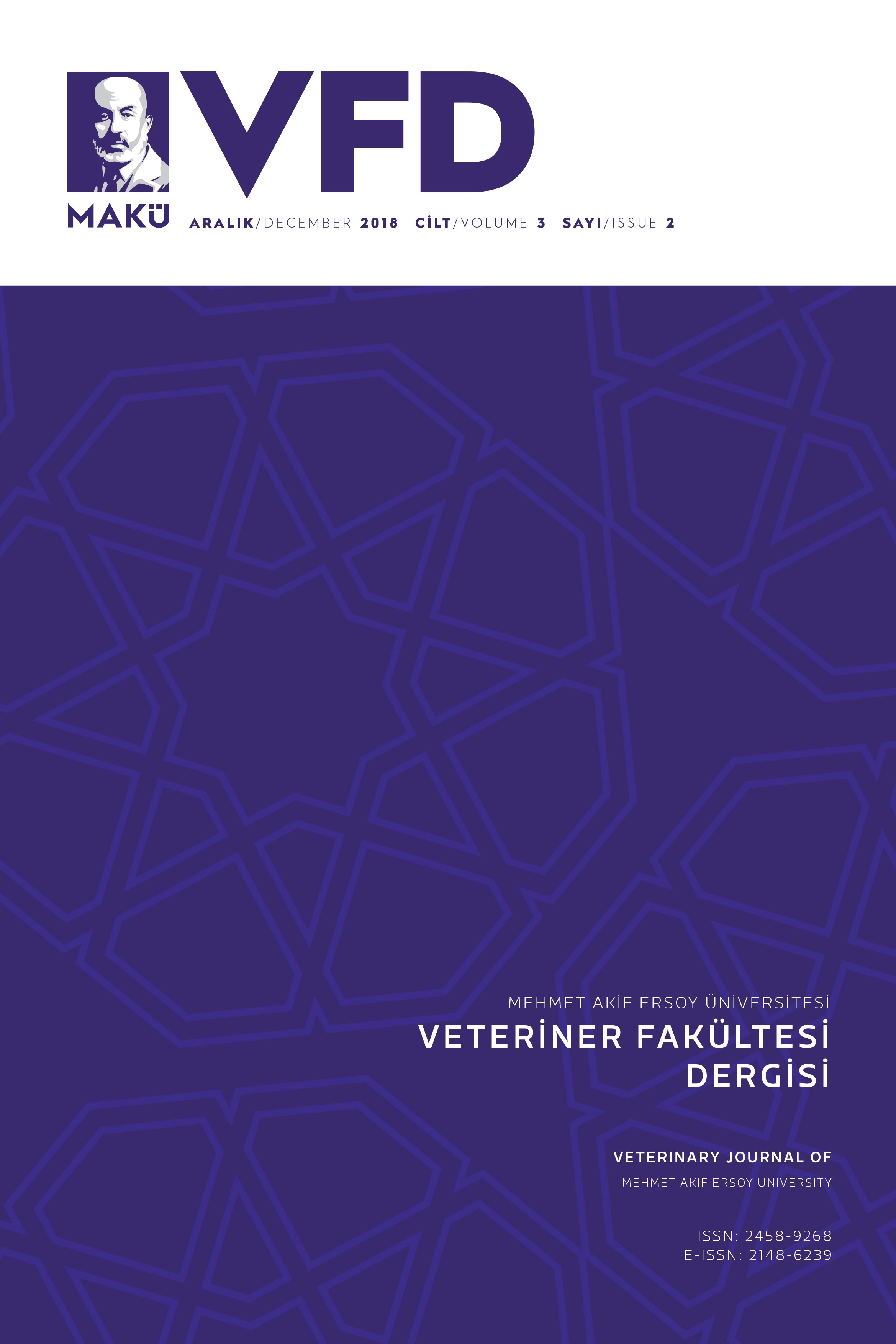Etiological Examination of Neonatal Calf Diarrhea Cases Detected in Burdur Region
Etiological Examination of Neonatal Calf Diarrhea Cases Detected in Burdur Region
Neonatal, calf, diarrhea, etiology, rapid diagnostic test,
___
- Alkan, F. (1998). The role of rotavirus and coronaviruses in calf diarrhea. Journal of Ankara University Faculty of Veterinary Medicine. 45, 29-37.
- Al, M., & Balikci, E. (2012). Diagnosis of rotavirus, coronavirus, E. coli K99 and cryptosporidium parvum with rapid test kits in calves with neonatal diarrhea and the relationship between enteropathogen and maternal immunity. Fırat University Journal of Health Sciences Medicine. 26(2):73-78.
- Azkur, A.K., & Aksoy E. (2018). Preventive measures in calf diseases. Lalahan Animal Res. Inst. Journal. 58(Special issue): p.56-63.
- Baljer, G., & Wieler, L.Ä. (1989). Pathogenese und immunprophylaxe der neonatalen Durchfallerkrankungen der Kälber. Vet. 5: 18-26.
- Bendali, F., Bichet, H., Schelcher, F., & Sanaa, M. (1999). Pattern of diarrhea in newborn beef calves in south-west France. Veterinary Research 30, 61–74.
- Birdane, M.F. (2017). Cryptosporidiosis diarrheas in farm animals. Kocatepe Veterinary Journal.10(2): 91-98.
- Citil, M., Gunes, V., Karademir, B. (2003). A retrospective study on diarrheal calves brought to KAU veterinary faculty internal medicine clinic between 1996-2001. Vet. Fac. Journal. 39-42.
- Duman, R., & Aycan, A.E. (2010). Prevalence of rotavirus infection in calves with diarrhea in Konya region. Journal of Anim. and Vet. Advances. 9(1):136-138.
- Emre, Z. & Fidancı, H. (1998). Prevalence of mix infections of Cryptosporidium spp., Escherichia coli K99 and rotavirus in the faeces of diarrheic and healthy cattle in Ankara, Turkey and in vitro resistance of Escherichia coli K99 to antimicrobial agents. Tr. J. Of veterinary and Animal Science. 22:175-178.
- Fayer R. (2010). Taxonomy and species delimitation in Cryptosporidium. Exp. Parasitol. 124:90–97.
- Foster, D.M., & Smith, G.W. (2009). Pathophysiology of diarrhea in calves. Vet Clin North Am Food Anim Pract. 25:13–36.
- Gul, Y. (2016). Internal diseases of ruminant animals. Medipres Publishing. 4th Edition.
- Kalınbacak, A. (2003). The use of hypertonic salindextran and oral electrolyte solution in fluid therapy of calves with diarrhea. AU Vet Fak Journal. 50, 113-118. Kaya, U., & Coskun, A. (2018). Determination of the etiology of neonatal calf diarrhea in the Tokat region. Manas J Agr Vet Life Sci.; 8 (1), 75- 80.
- Klein, D., Kern, A., Lapan, G., Benetka, V., Möstl, K., Hassl, A., & Baumgartner, W. (2009). Evaluation of rapid assays for the detection of bovine coronavirus, rotavirus A and Cryptosporidium parvum in faecal samples of calves. Vet J.182: 484–486.
- Kulig, C.C., & Coskun, A. (2019). Prevalence of E. coli, cryptosporidium, Clostridium perfringens, rotavirus and coronavirus in neonatal diarrheal calves in Sivas and its districts. Turk Vet. J.1(2):69-73
- Liu, L., Hägglund, S., Hakhverdyan, M., Alenius, S., Larsen, L.E., & Belák, S. (2006). Molecular epidemiology of bovine coronavirus on the basis of comparative analyses of the S gene. J Clin Microbiol. 44:957–960.
- McGavin, M.D., & Carlton, W.T. (1995): Special Veterinary Pathology, 2nd ed, St. Louis: Mosby. p. 48-58.
- Nataro, J. P., & Kaper, J.B. (1998). Diarrheagenic Escherichia coli, Clinical Microbiology Revievs. Vol 11, No.1. p. 142-201.
- Nydam, D.V., & Mohammed, H.O. (2005). Quantitative risk assessment of Cryptosporidium species infection in dairy calves. J Dairy Sci. 88: 3932–3943.
- O’Handley, R.M., Ceri, H., Anette, C., & Olson, M.E. (2003). Passive immunity and serological immune response in dairy calves associated with natural Giardia duodenalis infections. Vet Parasitol;113(2): 89-98.
- Roy, J.H.B. (1980). Factors affecting susceptibility of calves to disease. J Dairy Sci, 63(4), 650-664.
- Steele, A.D., Geyer, A., & Gerdes, G.H. (2004). Rotavirus infections. In: Coetzer JAW, Tustin RC, editors. Infectious Diseases of Livestock. 2nd ed. Cape Town: Oxford University Press Southern Africa; p. 1256–1264.
- Sahal, M., Terzi, O.S., Ceylan, E., & Kara, E. (2018). Calf diarrhea and prevention methods. Lalahan Hay. Research. Ins. Journal. 58 (special issue): p. 41-49.
- Sen, I., Güzelbektas, H., & Yıldız, R. (2013). Neonatal Calf Diarrhea: Pathophysiology, Epidemiology, Clinic, Treatment and Prevention.Turkiye Klinikleri J Vet Sci. 4(1), 71-78.
- Sentürk, S. (2018) Internal Diseases of Calves with Case Controversial. F Özsan Matbaacılık San ve Tic Ltd Şti, Bursa., Extended 3. Edition.
- Tokgoz, B.S., Ozdemir, R., Turut, N., Mirioglu, M., Ince, H., Mahanoglu, B., Yoldas, A., & Tuzcu, N. (2013). Determination of morbidity and mortality and risk factors of neonatal calf infections in Adana region. AVKAE Journal. 3(1):7-14.
- Uyunmaz, S.G., Bulut, O., Hasoksuz, M., & Hadimli, H.H. (2019). Investigation of bovine coronavirus and bovine rotavirus by rapid diagnosis kit and RT-PCR in diarrheic calf feces. Journal of Istanbul Veterinary Science. 3(3):57-63.
- Başlangıç: 2016
- Yayıncı: Burdur Mehmet Akif Ersoy Üniversitesi
Nevin TUZCU, Zeynep ÇELİK, Gökhan AKÇAKAVAK, Ayşegül BULUT, Rabia SALİK, Muhammed ÖNER, Vedat KAYA, Mehmet TUZCU
Total Phenolic Content, Antibacterial and Antiradical Properties of Bee Bread from Turkey
Nilay KEYVAN, Melike Sultan USLUER, Muhammet Mükerrem KAYA, Hatice Ahu KAHRAMAN, Hidayet TUTUN, Erhan KEYVAN
Etiological Examination of Neonatal Calf Diarrhea Cases Detected in Burdur Region
Reyda KIYICI, Nuri MAMAK, Şima ŞAHİNDURAN, Süleyman ŞENSOY, Hasan Altan AKKAN, Mehmet KARACA, Ramazan YILDIZ, Yavuz MUSABEŞEOĞLU, Halil İbrahim GÖKÇE
Morphological Investigation of the Veins and Bile Vessels of Rabbit Liver
Kamelia STAMATOVA-YOVCHEVA, Ömer Gürkan DİLEK, Rosen DIMITROV, David YOVCVHEV
Total antioxidant, total oxidant and oxidative stress levels in free-living birds
Evrim SÖNMEZ, Arzu GÜRSOY ERGEN, Sena ÇENESİZ, Ayris GÖKÇEOĞLU, Metin ÖĞÜN, Erdoğan UZLU, Metin ÇENESİZ
Investigation of ectoparasites in budgerigar and canaries in Burdur city of Turkey
Bahar ONARAN ACAR, Erhan KEYVAN
Decreased gene expression of RIPK1 and RIPK3, necroptosis players, in calves with sepsis
Atilla DOGAN, Yakuphan BAYKAN, Dilara AKÇORA YILDIZ
Effect of Vitamin C on the Immune System in Cattle Immunized With Blackleg Vaccine
